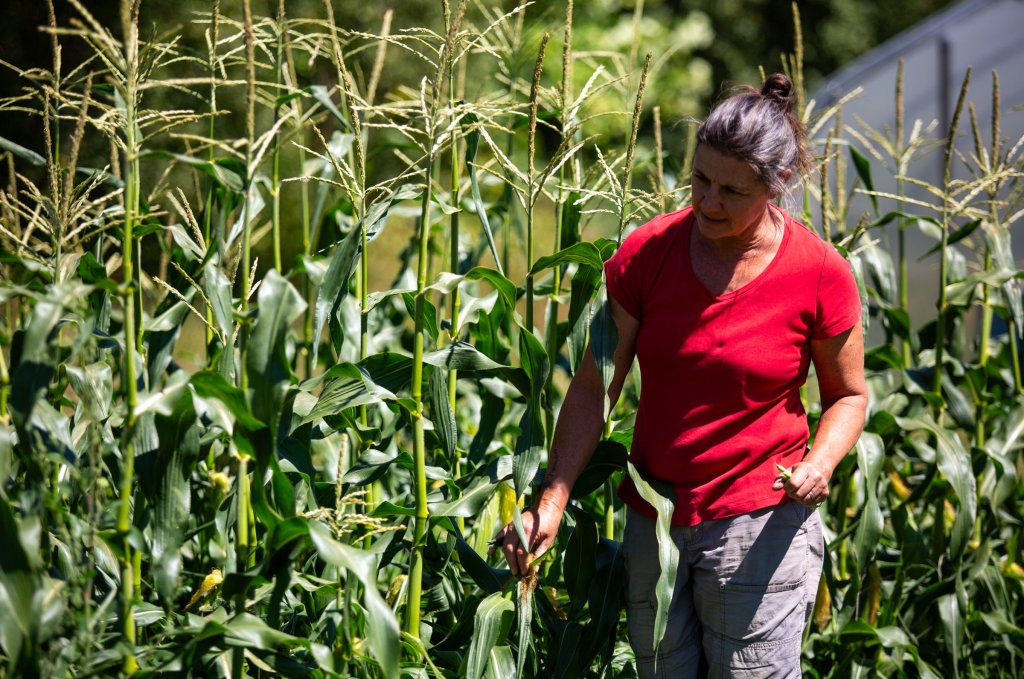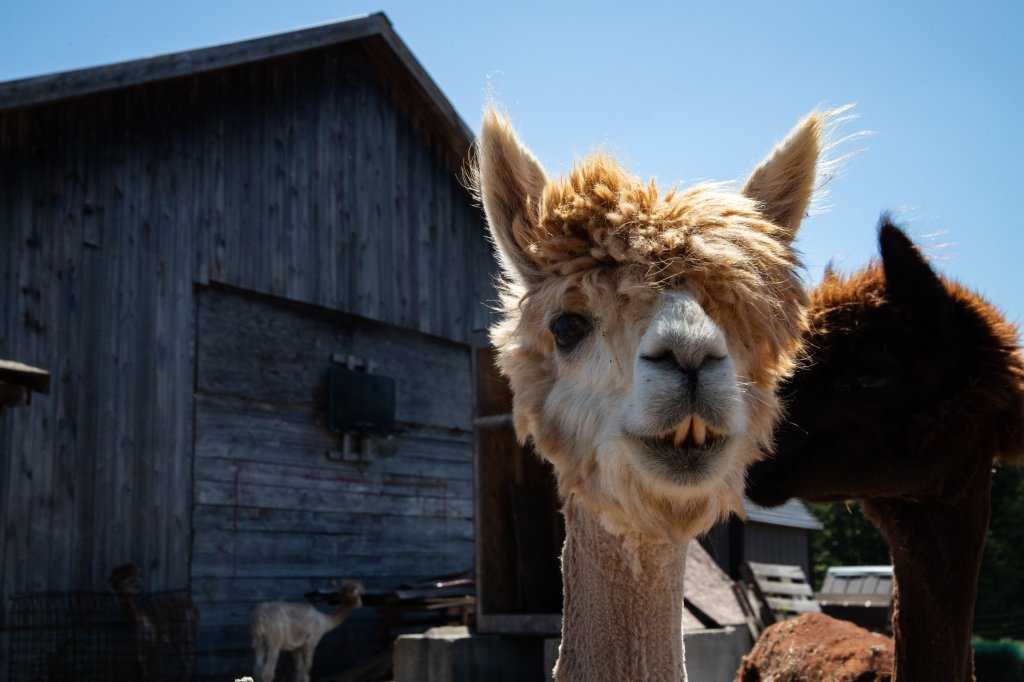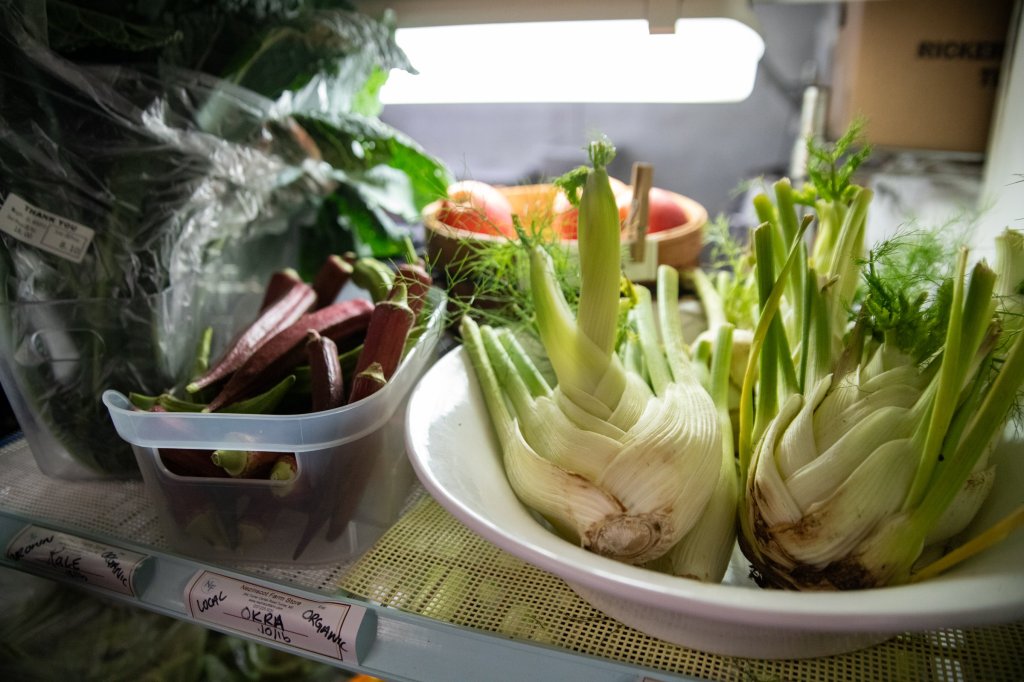
Keena Tracy looks over her corn crop Aug. 21 at Little Ridge Farm in Lisbon. The corn will soon be available for the 178 participants in her Community Supported Agriculture farm program. (Libby Kamrowski Kenny/Staff Photographer)
Many farms use Community Supported Agriculture programs to stabilize revenue. It is also a way for members of the public to give local farms a higher level of support than just shopping at farmers markets or farmstands.
Here is what you need to know to buy local food while providing farmers in your community more financial security.
What are Community Supported Agriculture programs and how do they work?
The philosophy has been around for a long time, said Alex Fouliard, manager of Maine Farmland Trust’s farm business planning program. How farmers set up their programs can be different though, depending on their needs and customer needs.
However, all programs require the customer to agree to a level of financial commitment upfront ahead of a growing season, she said.
In the traditional model, people sign up at the beginning of a season and then throughout the season they get a share of the food that is harvested, she said. Some farmers set up their program in less traditional ways. Some farms will band together to provide a multi-farm program. Sometimes farmers require a formal written agreement and some do not.
Gloria Varney, who operates Nezinscot Farm in Turner, has her program set up through a credit-like structure. There are various levels people can invest at and those funds become credit that can be used at her store and farm until they are spent, she said.
Along with that investment, people can also get some extra credit for items in the farm store, varying on the level of investment, Varney said.
Keena Tracy’s program at Little Ridge Farm in Lisbon is set up a little more traditionally, with customers signing up for a certain amount of food from her farmstand each week based on weight, along with access to other farm items that are in season that week, such as wildflowers and melons, she said. The amount of food people can take each week depends on the harvest at that time.

Curious alpacas look on from their enclosure Aug. 21 at Nezinscot Farm in Turner. Their coats are cut and the fibers are spun into skeins of natural wool sold on the upper level of the Nezinscot farm store. (Libby Kamrowski Kenny/Staff Photographer)
What type of food do you get through CSA programs?
The available food often depends on what the farm produces or grows, which in Maine can include seafood. Multi-farm programs will often offer a greater variety.
Tracy offers mostly vegetable and fruit produce, all certified organic. Varney offers a variety of food, including meat, dairy, organic milk, organic vegetables and fruit.
How often do you get food?
Typically boxes tend to be distributed weekly or biweekly, Fouliard said. However, distribution to program members tends to vary by farm depending on the length of the season and diversity of products, with some having monthly offerings.
Some farms will offer memberships year-round, while others only offer them in the summer or for a couple of seasons.
Varney, who offers year-round memberships, lets customers to spend their investment over time, allowing them to shop for items as they need them, she said.
Tracy offers weekly and biweekly boxes, she said. She offers her memberships twice a year during a summer and winter grow season.
How much do shares cost?
The cost varies by farm. For low-income individuals, Maine Harvest Bucks allows people with SNAP/EBT extra funds to buy local produce at participating farms through Community Supported Agriculture programs, farmstands and farmers markets. People can spend their SNAP/EBT benefits at farms approved to accept them.
For its summer CSA, Little Ridge Farm charges the equivalent of $13 per biweekly box pickup for its biweekly share, $21 per weekly pickup for its half share, $39 per weekly pickup for its full share, and $33 per weekly pickup for its prebagged customizable share. Customers usually pay in one lump sum at the beginning of the season or pay through 4-6 installments.
What are the benefits of buying local produce and products?
The benefits go beyond just revenue for a farm, says Emily Gherman-Lad, assistant director of engagement/communications at the Maine Farmland Trust. Often farmers are spending that money on the local workforce, advertising and products needed for their business.
“I think farmers are the backbone of our rural economy, and agriculture in Maine contributes $3.6 billion in economic impact each year and supports something like over 27,000 jobs statewide,” she said.
“And that’s not even counting how much money farms are spending on production expenses that often are staying in the local economy, to support local feed and supply stores or equipment dealers and machine repair shops, veterinarians, all those kinds of things, and of course, hiring labor and farm workers.”
Having a robust local food network also strengthens the state’s food security, which includes having enough food to feed everyone if access to outside food sources are shut off or limited, similar to what happened during the early days of the COVID-19 pandemic, she said.
Many farms also participate in the Harvest Bucks program, which helps low-income families buy local food by giving them bonus funds when they use food assistance money to buy products from local farms, she said.
Farming also tends to benefit the environment, helping to preserve land that would otherwise be developed, and sequestering carbon that would otherwise have been released, she said. Farmland also includes wetlands and forests, helping preserve some local ecology. Local food also relies less on long truck trips for distribution.
Local food tends to be picked when it is ripe and gets to people’s plates sooner because it does not have to travel long distances through a nationwide food network, giving people the full nutritional benefits of that food, she said.
Are there any Community Supported Agriculture farms in my area?
There are a number of farms locally. For more information on where to find them visit Good Food Council of Lewiston-Auburn’s website.
To find farms statewide visit the Department of Agriculture Conservation and Forestry’s website, realmaine.com. For a list of farmers offering Community Supported Agriculture and who accept Maine Harvest Bucks, visit its website.. For organic options visit Maine Organic Farmers and Gardeners Association’s website.


We invite you to add your comments. We encourage a thoughtful exchange of ideas and information on this website. By joining the conversation, you are agreeing to our commenting policy and terms of use. More information is found on our FAQs. You can modify your screen name here.
Comments are managed by our staff during regular business hours Monday through Friday as well as limited hours on Saturday and Sunday. Comments held for moderation outside of those hours may take longer to approve.
Join the Conversation
Please sign into your CentralMaine.com account to participate in conversations below. If you do not have an account, you can register or subscribe. Questions? Please see our FAQs.